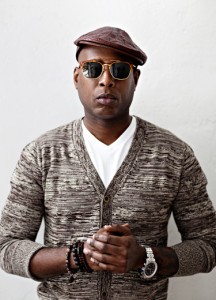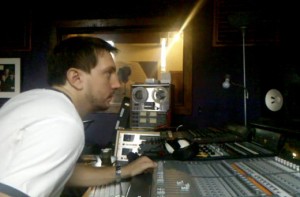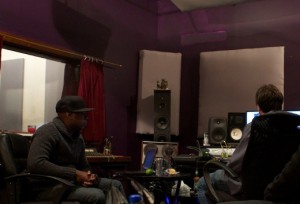Vocal Focus: Tracking Talib Kweli for “Prisoner of Conscious”
Talib Kweli kicks off Prisoner of Conscious with an outright lie: “I’m at a loss for words,” Talib Kweli declares in the intro for his fifth studio album – a statement that’s clearly contradicted by the 14 ensuing tracks.
Recognized as one Brooklyn’s most distinctive rappers since his first emergence in 1995, Kweli long ago proved he needed nothing more than a microphone to make an impact. Now the newly released Prisoner of Conscious (POC) has demonstrated that yet again, debuting in the Top 10 of Billboard’s R&B/Hip Hop Albums chart.
Those who are not into the potential of the human voice can go ahead skip this album. But if aural gymnastics, spoken and sung, is your thing, then don’t hesitate to tune in to POC. Created with a sharp crew of collaborators, Kwali’s capabilities are on display via the interlocking language and whirling maelstrom of “High Life” (featuring Rubix and Bajah), the dark flow of “Upper Echelon,” and the verbal jigsaws of “Push Thru” (featuring Curren$y, Kendrick Lamar and Glen “Grey” Reynolds).
In addition to his artistic colleagues, another frequent coworker of Kweli’s is NYC-based engineer Alby Cohen (Pharoahe Monch, Jean Grae, Ledisi, Devotchka, Kyp Malone, Break Science, The Ugly Club, The Zak Smith Band). A busy freelancer who spreads his sessions around multiple Brooklyn and Manhattan facilities, he began working regularly with Kweli in 2010, a studio partnership that was extended once again for POC with Cohen capturing many of the vocal tracks — plus other instrumentation — on the new record.
What does an artist require from an engineer on an album like POC, where vocals are front and center? It’s about much more than just setting up a mic. Cohen goes into detail about the specifics of recording Talib Kweli’s voice in this “Vocal Focus”.
Hear Kweli first-hand on “High Life”, one of the singles off of POC.
How long have you been working with Talib Kweli?
Kweli and I began working together in July of 2009 but we started working regularly in September 2010. I engineered on his two previous releases, his last solo record Gutter Rainbows (Jan 2011), and his side project Idle Warship’s Habits of the Heart (Nov 2011).
For both albums I recorded most of his vocals and a lot of the live instruments that were added in addition to the producer’s beat. I also had the opportunity to help arrange strings with my friends Gene Back and Chad Hammer on Idle Warship’s “Rat Race,” which would end up leading to more string work on his latest release Prisoner of Conscious (May 2013).
I have also done a bunch of other work for him on three mix tapes, The Blacksmith Community Mixtape (December 2010), Attack the Block (Aug 2012) and Northern Lights/Southern Smoke (unreleased). There are other songs out there, but I’m not sure what projects they are associated with.
How would you describe the characteristics of his voice?
Talib has a mid heavy voice. He has low end of course, but a lot of his voice lives in the mids, which is quite different than a lot of other rappers.
When it came time to record “Prisoner of Conscious”, what had you learned about recording vocals for Talib, both from an audio and workflow perspective?
From an audio perspective it always boils down to the gear that you have at your disposal and that dictates the decisions that you make. From a workflow perspective, it’s all about working quickly to keep the vibe flowing.
Adam Deitch (Lettuce and Break Science) and Eric Krasno (Soulive and Lettuce) were my teachers in that very, very important lesson when I used to assist and help out of their sessions:
Work quickly and make sure it gets done right.
There is a zone that Talib and I got into after a while. When he’s working on verses he’ll be meticulously working out the rhythms in the booth, and the moment you hear, “Let me do that again,” or he stops rapping, you have to make that decision as to whether he’s done or purposely leaving space…He gets very focused and I really love those moments when we get in it.
It’s like I’m John Stockton, he’s Karl Malone, and I’m setting him up to lay it in. It gets very quick and focused. The more in sync I am with him the easier it is for him to focus on his own approach. I was already a veteran on our workflow by the time Prisoner of Conscious was in progress.
So was there a “standard” signal path you established for recording Talib’s vocals on POC, or did it vary from song to song?
It changed as the studio where we worked at for a while added new gear.
Some of the vocal chains we set up included Neumann U 87 to Avalon 737, which was the best chain we had at that time.
Another was AKG C414 to a Vintech 473 to a Distressor — we also had an API 3124, but I preferred Vintech. I love the harmonic qualities of Neve circuitry. The studio didn’t own real Neve gear but the Vintech was pretty damn good. Dallas (Upton) makes a great product.
When we actually finished working on Prisoner of Conscious and did a few more sessions, I added my Mercury EQP, which is an awesome Pultec-style clone.
You told me that the recording for POC evolved as new gear options became available – what were some new choices that became available, and how did that change things for both of you in the studio?
First it was a Neumann U 87 going through an Avalon 737sp. When the studio I was previously working at began to get new gear, our signal chain began to evolve as well. Eventually a Vintech 473 was added so we opted to give his voice the Neve-style vibe.
But with the U 87, I also noticed that the harmonics in the 1073 style pre added a lot of sibilance and mids to his already mid-heavy voice. So we changed to an AKG C414 BLS, and it seemed to work better as it had a slightly less overstated high end.
Beyond the signal path, were there other things you did in the studio to help Talib deliver his best possible vocal performance (things like dimming the lights, etc.…)?
I was always available — morning, afternoon and night well into the next morning. If he needed me I was there. I rarely ever said “no.”
In general it’s just about knowing what the client likes and being able to setup an environment that caters to that specific person’s creativity. It might be as little as having his favorite drink there when he walks in.
I used to work in advertising and much of the process of retaining accounts was simply to know what the people on the other side of the table liked. Of course in this field I really love what I do, so I always just translate those corporate experiences to this current career path.
This is a service industry as well as a creative industry. Being able to offer your client the most relaxing experience isn’t something most people ask for or expect — and Kweli never asked I just offered and provided, he is very unassuming in that regard, he just wants to make music. But going that extra mile is a way of showing your clients how much you care about them, and it’s one more way to make their experience with you more enjoyable and the vibe for creativity more vibrant.
Audio is a service industry, no doubt. You said that working fast is an important facet of working with Talib. What adjustments did you make to your own workflow in order to be able to keep up with his creative pace?
As I mentioned before it’s mainly about being on his rhythm and working quickly.
As a drummer I used my ears and my fingers to be quick on the transport and in editing. Sometimes you get tracks that are definitely not on a flat BPM and you need to work quick to get those beats on a click because at any moment he might want an edit, or switch the second verse to the first just to hear how it sounds. Again some engineers are quicker than others, but these skills are very important — it’s like rudiments for a drummer.
Some of it is more production oriented. The first time I suggested that strings would be a cool addition, he wanted to cut it the next night. He asked me to put the guys together, the next night we did it and it came out great.
That was for “Rat Race” on Idle Warships’ Habits of the Heart, which we were recording simultaneous to the Prisoners of Conscious album as well. Over the next couple of months we did this for a few more songs on Prisoners of Conscious, including “Hamster Wheel,” “Human Mic,” “Before He Walked,” and “Fly Away” off of the Attack the Block mixtape.
Last question: What’s particularly satisfying to you about recording vocals — how do you continue to evolve your techniques in that specific area of audio engineering?
I find recording anything satisfying, but in terms of recording vocals it’s about matching the right piece of gear to the voice. I love it when someone says to me that they never had their voice sound that good.
The more gear you get to use it adds to your production vocabulary. I became a good engineer because I learned how to make something sound good in a bad or mediocre room. When I started working in different rooms and had a chance to work on different pieces of gear I became more versed in how things work. I wasn’t formally trained; I picked my skills up from anyone and everyone that had an opinion about something.
Trial and error solved the rest. After some years you tend to just figure out what works and what doesn’t — you hear a voice and in your head you start to put that perfect chain together for them.
On the production side, I have a pretty good sense of harmony so when I work with vocalists I enjoy being able to help them get through certain parts, maybe suggest a good harmony. Sometimes a vocalist will get frustrated on the same part. Most of the time it’s not skill deficiency, its more pronunciation, enunciation and breathing.
Even though I’m not a trained vocalist I have some perspective, and sometimes even great vocalists need to be reminded in that one moment when they are feeling frustrated in the booth that there might be a different approach. I never really did that with Kweli though, only the occasional mention of a word that wasn’t as clear.
Even so, if you hear something, say something — as long as you are sure. It’s always better to tell them before they discover that, in fact, there is a problem with a part.
— David Weiss
Please note: When you buy products through links on this page, we may earn an affiliate commission.










